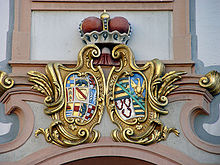Loßburg sandstone


The Loßburger sandstone , also Loßburger plate sandstone , belongs to the plate sandstones . It is quarried in Lombach near Loßburg in the northern Black Forest in Baden-Württemberg and originated in the geological time of the Upper Buntsandstein .
Rock description and mineral inventory
It is a purple to dark red sandstone with mica deposits, which appears pink in its appearance. It is clay-ferritic (clay-iron) bound and shows the smallest evenly distributed clay nests on its surface.
Its components are 68 percent quartz , 21 percent rock fragments, 9 percent alkali feldspar , 2 percent muscovite and the accessories biotite , rutile , apatite and opaque (opaque) mineral grains. The grain size is 0.05 to 0.3 millimeters. It is a weakly feldspar-bearing sandstone with fragments of rock.
use
Due to its clay-ferritic bond, it is only weakly weather-resistant, sand, flakes and turns off. When installed perpendicular to the warehouse, large-scale formwork phenomena are preprogrammed, which are favored by the flat-layered mica, biotite and muscovite. The Lossburg sandstone was used, for example, at Bruchsal Castle and Ettlingen Castle .
The natural stones are used for monumental structures in structural engineering and bridge construction, level and profiled stone, floor slabs, house plinths, troughs, monuments and tombs as well as for floor and wall slabs and filigree stone carving work.
Web link
literature
- W. Dienemann and O. Burre: The usable rocks of Germany and their deposits with the exception of coal, ores and salts, Enke-Verlag, Stuttgart 1929, p. 242f.
- Wolf-Dieter Grimm: picture atlas of important monument rocks of the Federal Republic of Germany. Published by the Bavarian State Office for the Preservation of Monuments, Lipp-Verlag, Munich 1990, ISBN 3-87490-535-7 , Gesteins No. 088.
Individual proof
- ^ Grimm: Monument Atlas of Important Monument Stones. Rock no.088 (see literature)